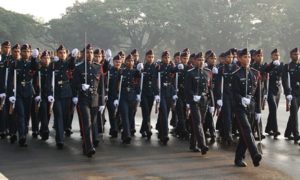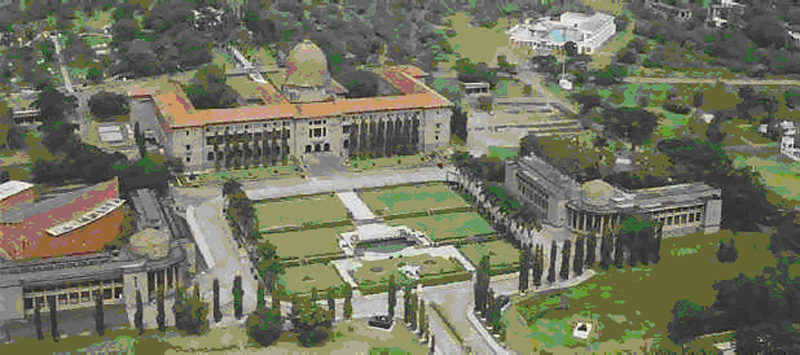National Defense Academy Faces Unprecedented Burnout
A report prepared by the Indian military reveals a huge rate of burnout of cadets at the country’s premier military training institution
By Parth Satam January 4, 2018

India’s premier military training institution, the National Defense Academy (NDA), is facing an unprecedented burnout. Between January 2008 and November 2017, as many as 1,256 cadets quit the academy. This amounts to between 16% and 20% of the intake each year.
The excessive nature of the unsanctioned rigor at the NDA is purportedly leading to one-fifth of the cadets failing to complete the courseTop of Form
A report jointly prepared by the Integrated Defense Staff Headquarters and the NDA, accessed by Asia Times, has revealed the rate of young cadets quitting the institution.
The NDA is arguably the only military training institution of its kind. Sixteen-year-olds join the Pune-based institute as army, navy and air force cadets after passing an entrance exam and a five-day personality, psychological and medical examination. They receive a bachelor’s degree at the end of three years and then enroll in their respective service academies – the Indian Military Academy (IMA), the Indian Naval Academy or the Air Force Academy – where they train to be future commissioned officers.
NDA alumni squarely blame ragging, “unofficial training” and excessive physical punishment for the high attrition rate and describe the torture at the hands of senior cadets as sadistic and misguided.
Retired Colonel P K Royal Mehrishi, an NDA alumnus, explained how senior cadets ask juniors to roll down staircases of three-story buildings, vault over a wooden horse, do backflips, hand-springs etc without the supervision of any qualified instructor.
“Senior cadets believe they’re toughening them for war or better performance in the hard-fought inter-squadron competitions,” he said.
A former NDA instructor, retired Colonel Vinay Dalvi, said senior cadets often justified the punishments as a mode of getting the freshmen into the grind. He said a senior cadet, or the overstudy, often faced punishment from divisional officers for newcomers’ mistakes. This, he said, put severe pressure on the freshmen.
Ankur Chaturvedi, a former NDA cadet, reveals that the bulk of the injuries are reported during the initial terms. He sustained a kidney injury during a boxing bout and left the academy in 1996.
Retired Air Marshal P P Rajkumar, a former deputy commandant and alumnus of the NDA, confirmed the long-standing culture of ragging and unstructured training. In 1975, a senior cadet lost his life after juniors assaulted him for all the physical abuse he had put them through, he offers as anecdotal evidence.
“This happened during the run-up to the passing-out [graduation] parade when the departing cadets bury the hatchet with the juniors while parting company in an event called Socials. Here, the junior cadets in the squadron are allowed to rag the sixth-senior cadets in a friendly setting. However, a group of juniors hit him so hard that he died,” he said.
Too Exacting
Colonel Mehrishi suggests that the NDA’s revised physical standards are a bit too exacting, even more than that of commissioning academies such as the IMA. Retired Brigadier L C Patnaik points out that even cadets with backgrounds in sports find themselves underperforming in tasks such as a front roll. He pointed out that this is apart from the late-night unofficial punishments, which cause complaints of dizziness, headache, fatigue and changes in sleep patterns.
In his book Quality Military Leadership, Colonel Dalvi quotes a former director and commandant of the Armed Forces Medical College, retired Air Marshal B Keshav Rao, who had carried out an assessment of the NDA’s training regimen: “Inadequate rest between periods of intense physical exertion, inadequate sleep, missing meals and inadequate focus on personal hygiene [and] off-syllabus physical activity at the squadron level mitigated attempts at scientific and structured strength and stamina building.”
“Relegations,” “withdrawals” and “resignations” are the three heads under which departures from the academy are classified, depending on whether the cause was academic failure, rustication, medical fitness or voluntary separation. “Relegations” refers to repeating a semester for failing an academic or outdoor training (ODT) test. Dalvi said that sometimes the reason for relegation might be both, because a cadet is too exhausted to focus on studies, thereby flunking his exams or not having adequately recovered from the grueling physical regimen to crack the ODT.
Two consecutive relegations can lead to a “withdrawal,” which is a permanent release from the academy. It can also be on disciplinary or medical grounds. In the case of “resignations,” the cadet can choose to leave the academy within two weeks of joining, without paying the NDA the 1.35 million rupees (US$21,250) incurred on his three-year training.
It is not the only armed-forces institute witnessing burnout. According to the Directorate General of the Armed Forces Medical Services, the hospitalization rate among officer cadets across military-training institutes in the country between 2013 and 2015 was 34.14%.
Officials at the NDA did not respond to a detailed e-mail query sent on December 15, citing the absence of officials and staff on account of the mid-term break. This story will be updated if they respond.
An aerial view of the historic Sudan Block at the National Defense Academy. Photo: Wikimedia Commons
Need For Scientific Methodology
Both Colonel Dalvi and Brigadier Patnaik recommend phased training that progressively increases the physical strain. Dalvi said cadets’ endurance and strength would have peaked by the time they graduated as officers. Patnaik recommended a scientific assessment of cadets, such as muscle and bone-density testing, before subjecting them to the rigorous regimen at the NDA. He said a dedicated department of physical education should be set up to oversee the cadet for the first year, with the proportion of military training gradually increasing in the last two years.
For retired Admiral Arun Prakash, former navy chief and commandant of the National Defense Academy, the remedies lie in the service headquarters paying greater attention to the training academies and ending the ad hoc methods in appointing the commandants. He said the commandant is a three-star officer, usually slated to retire within a couple of years. He argued that the commandant should ideally be a two-star officer, with another promotion left to go.
“A blue book for academies, prepared by the Chiefs of Staff Committee, with inviolable rules for their functioning, should be introduced. No commandant or instructor can introduce their own ideas,” he proposed.
Colonel Mehrishi advocates a mandatory supervision of all training and punishment by qualified instructors with a “ruthless, zero-tolerance ragging policy.” Most military veterans Asia Times spoke to believe that the problem also lies with the outdated officer-selection system.
Brigadier Patnaik says the existing personality and psychological tests that assess “officer-like qualities” only consider the behavioral process and observable responses, neglecting the mental processes that trigger actions and decisions. He points that out tests such as the British Army Recruitment Battery and the Australian Computerized Cognitive Assessment Tool judge the mental processes and not the response.
Medical tests, Patnaik insists, should be revised to include exercises such as 1.6-kilometer shuttle runs, pushups, chin-ups, sit-ups etc to match with the physical capability required during training.
Dalvi argues that the British Raj-era selection and training system has destroyed the careers of many talented young potential officers.
(Parth Satam is a Navi Mumbai-based freelance writer and a member of 101Reporters.com, a pan-India network of grassroots reporters.)
Courtesy: Asia Times
Editors Note:
Having graduated from the NDA, I can say that a certain amount of ragging does take place, but it was never vindictive or violent as now seems to be the case. To say “that even cadets with backgrounds in sports find themselves underperforming in tasks such as a front roll”, is rubbish.
Extreme cases of ragging may be the exception rather than the rule. The Divisional officers of each squadron need to keep a strict watch on the activities in the Squadron lines, especially during silent hours, to ensure that the ragging does not get out of hand.

